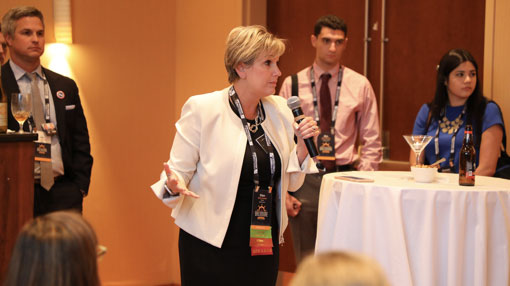“The number one problem is fear,” said Tracie McKinney, News Director at Scripps’s KTNV in Las Vegas. “We’re afraid of losing our audience.”

McKinney, who credits her own experiments for her move up from assistant news director at WXYZ in Detroit to the Las Vegas job, was talking about barriers to innovation at a reception and informal conversation the Knight-Cronkite News Lab hosted at the RTDNA’s “Excellence in Journalism” conference in Baltimore this fall. TEGNA’s News VP Ellen Crooke, a noted evangelist for fearless change, was there too. “We should be terrified of NOT being innovative,” said Crooke. “Not taking action is even scarier than trying something new.”

It’s a bit of a paradox. The news directors and other executives we’ve interviewed for the Knight-Cronkite News Lab project on local TV news innovation all agree that there’s too much sameness in their business and nowhere near enough experimentation – even on digital platforms — and yet the problem stubbornly persists. Here are five reasons why it’s so hard to break with the familiar.
1. The Audience Trap
McKinney and her fellow news directors acknowledge that it’s a lot easier to chase away the viewers and users you have than to attract new ones. The people who watch local TV news like it the way it is – they’ve certainly had decades to get used to the formula – and the “switching cost” of changing the channel to a competitor is zero. So the fear is your loyal base will “punish” you if you tinker too much with the tried and true. When I worked at CBS News, I had my own bromide to describe this phenomenon: “The people who are keeping us alive – are killing us.”
2. The Resource Trap
News directors say they are strapped for people, money and time. They’re “asked” to expand their news hours with minimal if any additional resources. Freeing up a team to create and implement experiments sounds great, but who’s going to cover the 4, 5 and 6? As Ellen Crooke put it in an earlier session at the same RTDNA conference, “We have to give our journalists the opportunity to get off that assembly line.” And changing metaphors on the fly: it’s hard to look at the map when both hands are gripping the wheel just to stay on the road.
3. The Mixed Messages From Management Trap
News directors complain about their bosses – no headline there – but in this case, the beef is that the higher-ups want them to change while hitting their ratings and revenue targets. Given the real or perceived likelihood of losing viewers and even digital users in the short term, it’s small wonder that the immediate perils of innovation can outweigh the potential for payoffs down the road. Tracie McKinney: “When you take a risk, it might not work the first time. You have to have the support of the people above you to take that risk.”
4. The Success Trap
It may sound odd, but local TV news operations are to some extent the victims of their own prosperity. For too many years, a comfortable oligopoly has protected even the mediocre players: there was enough money in the market to go around. In theory, the #2 or #3 station in the market should be incentivized to try something new, but those changes are often incremental variations on the same themes: build a new set, launch a different promotion campaign, re-shuffle the anchors. It’s been too easy to make money the old-fashioned way, too risky to try anything bolder. At least until now.
5. The Culture Trap
This may be the most daunting barrier to meaningful change. Over many decades, local TV newsrooms have developed a culture of conformity – one station manager called it “incestuous” – that can stifle innovative ideas. It’s our old friend the fear factor again: what will my peers say if I try this – especially if it doesn’t work?
Ironically, cultural conformity can prevent executives from taking advantage of an enormous asset that is right under their noses. It’s the reverse apprenticeship model, in which the people in charge learn from their own young employees, whose media habits mirror the generation newsrooms most want to attract. Ellen Crooke says some of the best ideas at TEGNA come from the newest members of the team. “We encourage them to create a product that you or your friends want to watch.”
And finally, cultural resistance can impede recruitment of the best and brightest. A reputation for rigidity — training for sameness rather than rewarding distinctiveness — is hardly a draw for innovation-minded graduates tempted by Google or Facebook.
What’s the secret to overcoming these barriers to innovation — the fear of the unknown? The secret is there is no secret. These “traps” are real, and avoiding them requires patience, imagination, and a willingness to take chances.
We at the Knight-Cronkite News Lab will do our part to help. Subscribe to our newsletter and keep checking this digital innovation hub for examples from around the country of people who have conquered the fear factor, even if they haven’t yet figured out all the answers to what comes next.
The noted philosopher Yoda said, “Train yourself to let go of everything you fear to lose.”
The noted news director Tracie McKinney said, “The only obstacle I have is me.”
Additional reporting by Charlene Santiago
Do you have experiments involving new programs and platforms that you’d like us to check out and share? Email us at cronkitenewslab@asu.edu.
Get the lab report: The most important stories delivered to your inbox
Related:
Article: Local TV News and the New Media Landscape. Read here.
Article: “Thank God you’re not in newspapers”: Local TV is doing way better than you’d think, a new report suggests. Read here.